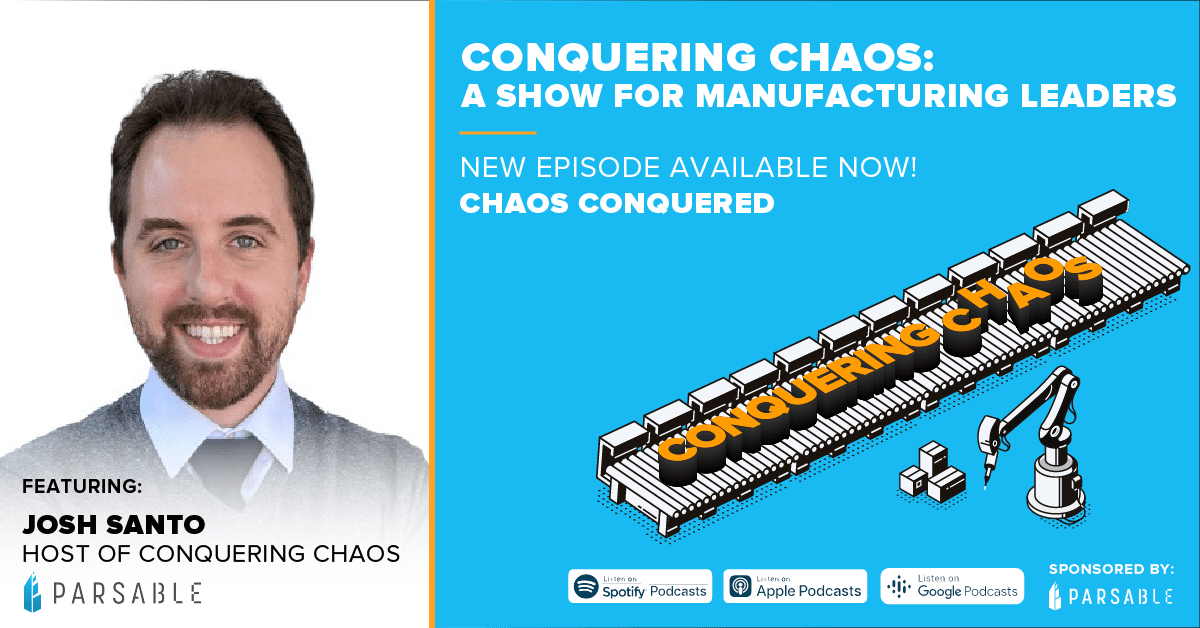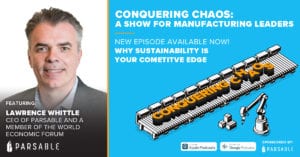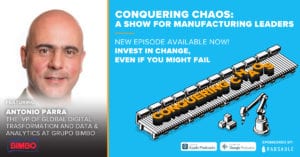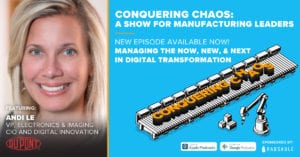Chaos Conquered

We came, we saw, we conquered chaos.
Josh Santo, hosts the final episode of Conquering Chaos.
It has been a long, meaningful journey for the show and we take a look back at the top and favorite episodes from the show’s run and recap what made this show so special for industry experts and what we all learned from it from each and every episode.
Thank you for listening!
Join as we discuss:
- Final Episode of the podcast
- Top episodes for the show
- What we learned and accomplished throughout the show
___________________________________________________________________________________
Experiencing disruption on the frontline? We can help. Request a demo today.

___________________________________________________________________________________
Check out the final episode transcript below:
It’s important in life to conclude things properly. Only then can you let go. Otherwise you are left with words You should have said but never did in your heart is heavy with remorse. Life of Pi. Welcome back to Conquering Chaos, the show for manufacturing leaders. Now listen up. We here at the concrete chaos studios have an announcement to make. So brace yourselves. Are you braced? Are you sitting down? Have I triggered your anxiety enough at this point? This is the final episode of Conquering Chaos. So today’s short episode is focused on concluding things properly, so that we can move forward together onto the show.
One of the best aspects of getting to host an industry podcast is meeting new people, everyone and I mean everyone has unique skills and perspectives and ideas to share. Because we’re all different. And with different backgrounds and skill sets and life experiences that enable us to see things that others don’t always see. I learned so much from each guests that joined us over our 50 Episode run such smart and insightful people joined us and that sometimes, candidly left me questioning whether or not I could keep up whether or not I could ask questions that were worth these people’s time that came across as in some way intelligent and knowledgeable on the topic so that I could make sure to draw out their perspective and their unique ideas that sometimes they didn’t even know that they had. And compared to them, I was very much like Jon Snow from Game of Thrones. I knew nothing. I knew nothing. In fact, if I was a great podcaster I would insert a clip right now of Ygritte telling Jon Snow, “You know nothing, Jon Snow.” Like I was learning right there with all of your listeners.
They say that people won’t remember what you say, but will remember how you made them feel. And I candidly don’t remember all of the points and the conversations I’ve had with the manufacturing leaders here on the show. But I do remember how some guests made me feel, which I think translated into my most favorite episodes. So my top seven-ish just looking back on the run of Conquering Chaos. Episode Five, millennials on manufacturing with Jake Hall, the manufacturing millennial. This is a fun episode because Jake Hall is a really cool and interesting guy. If you haven’t heard of him, go on LinkedIn. Search for Jake Hall search for the manufacturing millennial, and enjoy the content that he puts out there. He has made it his mission to educate the younger generations about how cool manufacturing actually is to help dispel some notions that have built up over time. The idea is that manufacturing is our is dark, dirty and dangerous. And making sure that there’s content out there in a consumable, enjoyable format that really showcases the really cool and unique things that people get to work on and do in manufacturing. He posts a lot of cool videos showcasing automation, and how working with that technology is what enables the industry to bring a mass amount of goods to the millions and billions of people worldwide who need to consume them. Really cool guy, really interesting to follow all of the activities that he’s a part of. He goes to tons of conferences, he’s on podcasts, he’s on webinars, he’s putting out his own content. And he takes time to partner with local organizations, even his own high schools, his former high school’s robotics class to again really encourage the next generation of manufacturers so check out his episode, Episode Five and follow him on LinkedIn.
Episode 14, evaluating new technology for industry 4.0 with Don Meier from Deloitte. John was such a cool guy to get to talk to. In fact, we not only talked together we had tacos together so it was kind of a tech and Taco talk, I guess, in a way, but in that episode, Don shared his experience with helping work on the smart factory at Wichita with Deloitte, which is where they brought in all the industry 4.0 digital transformation technologies, and put a strategy together for implementing them in an actual running factory to demonstrate how these technologies come together. Particularly what they emphasize is this idea of an ecosystem approach, how you’re not going to find just one solution to rule at all. And it’s going to be more like the fellowship of technology. Right, so it’s not the One Ring to rule them all. It’s the fellowship that ultimately comes together, and ushers in the new era of peace for you, Lord of the Rings fans. Now Don was cool to talk to you because he’s really good at taking complex ideas, and simplifying them, which is a mark of someone who really understands in and out the topic that they’re speaking on. And we actually get to talk about our favorite taco spots, and then try a new Taco spot together here in Austin because Don and I are located in the same city. So overall, you can see why it felt like a pretty good episode. In a pretty good connection.
Episode 17 people solve problems with Jamie Flinchbaugh. Now this was a cool one. Because Jamie had a book coming out, people solve problems. And prior to its release, he sent me a copy so that we could talk about it on our episode together. Now Jamie is not only a smart and humble guy who happens to run his own podcast, with a friend of his called “Lean Whiskey” in which he gets together with his buddy over a glass of whiskey on the rocks, I believe, and talk about Lean concepts and principles. Really cool. Really fun, very similar to another podcast out there called “Manufacturing Happy Hour” hosted by Chris Lukey, who grabs a beard and interviews the guests. Really cool podcast. So check that out as well. Now with Jamie, one of the things that took away from his book was the need to prioritize problem solving. And that doesn’t mean issuing a decree that people must solve problems, it means carving up the time. So people have the space and the bandwidth to think, imagine, explore, be creative, because that’s what’s going to lead to problem solving. So if you want people to help you solve your problems, you have to prioritize the space needed the time needed to make that happen. And that was one of my big takeaways.
Of episode 18. Worker retention, it’s not rocket surgery with Jim Parker from Inline Plastics. When I recorded this episode, it was immediately one of my most favorite episodes. Jim is not only a caring and thoughtful leader, but he’s humble. And he showed a vulnerability on the show that you don’t typically find with people. He did it by talking about a topic that might might lead to some embarrassment for companies who went through a similar experience or who are going through similar experience. And he shared it and he was open and honest about what they went through. And how they took the ownership as a company to drive improvement to retention. They didn’t point the fingers and say, Oh, it’s it’s other people’s problems. People don’t want to work. Now don’t get me wrong. They did at first. They were punitive. At first, when people were showing up late from breaks consistently. They were having talks with HR, they were having marks on their record, I can’t remember the word that he used to describe it. But every company has some sort of descriptor for the marks against you, on your record as accounted for by HR. He said that they had lines out the door of HR meetings needing to happen and getting backed up because people were so consistently coming back late from breaks. At no point during that time, did they stop and ask themselves why this was happening? There’s kind of this underlying assumption that it was negligence, which was wrong. As it turns out, when they started digging into it, when they started to try to understand what was the root cause when they applied the same principles of the five why’s that we do in manufacturing to this particular situation, they found that the problem was on their company. People were leaving on their brakes for a very specific and personal reason that the company had some sort of control over. And because the company was not delivering in that instance, it forced people to go outside the company. And by solving that problem, they saw an immediate change to these issues that they were having. And the point that I bring up here is one, being willing to acknowledge that your place of work is not a perfect place to work. It’s just not. And by acknowledging that, and asking the people who you are there to serve. Asking them what would help make their lives better, what would make it easier to work for you? Then you can come up with a plan. Then you can find new ways of making sure that people want to stay and even start referring people to your organization. it and that’s what I loved about it. It took this concept of Extreme Ownership something that Jocko talks about, by the way, check out Jocko podcast if you haven’t Extreme Ownership, what is it that I have control over? What can I do in this situation, not pointing the fingers, accepting responsibility and doing the hard work to get the results that you’re looking for. And that’s why I love Jim’s episode.
Episode 36, the blueprint for getting 20% more throughput quality and rewards with Tom Shorma. Tom was faced with a good problem, you might say it, the problem was that they needed to produce more, they couldn’t meet their customer demand. And that’s a sign that business is booming. So you know, it’s not great to have problems. But if you were to pick certain problems, this might be a problem, you’d be okay with having your product is so good. Your customers love it so much that they want more, and you’re just not able to keep up with it. So that was a challenge that presented itself to Tom and team. And they created a plan for getting 20% more throughput, on average across their facilities within the next five years. And they were actually able to accomplish that goal in three years. And it started with Tom gathering his people and letting them know that he was going to ask 20% more from them. And to start this out, he was going to give them 20% more upfront. So he immediately provided his workforce with 20% raises. That to me is such a great example of leadership, of taking care of your people, of uniting them, and finding a way to make sure that everyone is in this together. Because ultimately, that’s what a company is, it’s a group of people coming together to accomplish these goals. And you cannot forget that. And one of the things people rely on is PE. And so that was such a great example of leadership from Tom. Now the impact was well worth it, the return on investment was well worth it, they were able to on average produce 20% more throughput, with 20% less quality issues within three years. And Tom laid down the exact approach that they took. And it was all about listening to your people. They sourced the ideas for improvement from the people on the factory floor. In fact, he had to coach his management team because when ideas would come up, sometimes they were dismissed as little ideas, not value producing ideas, the team was looking for the big ideas that was really going to drive that return on investment. And Tom had a coach’s team to pay attention to every single idea to listen to respond. Because when you do that those little ideas lead to the big ideas. But if people don’t feel like you listen to their ideas, they’re not going to keep proposing the ideas to get to the big idea. He shared an example of an individual who just his idea was to give him a broom at his station so he could keep it clean. And that was quickly dismissed as such a little idea that won’t really drive the value that they’re looking for. And Tom and team had to coach to say, Listen, we want to hear from people, we want to show them that they’re responding. And if it’s something that’s within our power to do, let’s do it. Let’s give the guy a broom. And so they did. And that led to a request from the same guy to not just have a broom, but to have a vacuum because that’ll make it go a little bit faster. And so they said yes. And then eventually, after a few more ideas, this individual created a way to avoid the production of the scrap that he was having to clean up, which ultimately saved them a significant amount of money. After the hour by hour, day by day, month by month use of this particular machine, that wouldn’t have happened. Had they said no to that first idea.
Episodes 46 through 48, the connected worker movement with Jaime Urquidi. The Connected worker movement was a little mini series that we did focused on breaking down what’s happening in the industry. What are the inefficiencies that are commonly encountered in frontline workflows and processes, how that’s making an impact and how technology like connected worker is the thing that will empower people to overcome those inefficiencies. And we had this conversation or these conversations I should say with Jaime Urquidi, who is by far one of the most enjoyable people to speak with on the topic. of manufacturing, he’s got 20 plus years of experience, worked as a plant director of multiple sites at one point in his career. And he dealt with so many different challenges during his tenure. And he found creative ways to overcome them drawing on lessons that he learned in his study of lean in his work with his own mentors, and through trial and error. And so it was a really fun conversation, to hear Jaime, really bring these issues to light, tell the stories that really emphasize the experience that he had, and how he went about solving it and his personal experience. By implementing connected worker technology. Jaime, realized he had a passion for this technology and joined Parsable. And that’s where we got really introduced and spent a lot of time together so that we could really just work together and help spread this message. He’s certainly an evangelist of this movement. And I encourage everyone to connect with Jaime on LinkedIn, or anywhere else, because he’s just a fun guy to talk to you.
And finally, Episode 50 XR at work with Scott Burkey. Now we just recorded this episode. In fact, it just went live. It’s our most recent episode. And I think that was by far our best episode. Now, I know it runs a little bit long. But Scott is such an engaging personality to discuss these topics with, he’s a technology Fellow at a global manufacturing company, it’s his job to bring in technology to the different factories within the company. He’s got a whole team, or at least he did at one point, he helped to build a team. And now he’s more in a consultative role. And he really focused on extended reality, which includes virtual reality, augmented reality and mixed reality in if you recall, from the last episode, my mind was blown by mixed reality. And I’m so excited to see that technology mature and become something more common in the workplace. Now, Scott is also a podcast host himself, he hosts a podcast called XR at work, where they bring their insights from working with this technology, implementing it at their manufacturing facilities and talking with others like themselves, about this technology. So if you want to learn from people in the industry, that’s the podcast to check out. Scott is passionate. He, like me did not start in manufacturing, but found his way and found a love and a passion for helping people on the frontlines of manufacturing. In fact, that is really become a mission in Scott’s life a purpose. He’s very much a mission driven, purpose driven individual. And his passion comes through in the conversations that we had together, not just on the podcast, but even leading up to that. He’s fun guy, smart guy, and has that practical hands on experience of taking technology and finding the fit for it. I encourage you to check out that episode, if you haven’t listened to it already.
Now, that’s my list. I’ll still be on LinkedIn. So if there were any episodes that you would add, let me know, I would still love to hear it. Now throughout the run of the show, we hit a bit unexpectedly on a message that was ultimately iterated over and over in different ways across just about every episode. And by examining that common message that that thread, connecting all of the advice, lessons and stories shared on the show, we found a principle, a law that serves as the key for bringing order to chaos. Empower your people. It’s a simple idea, but it’s one that is sometimes a bit complicated. Because there’s so many reasons why you quote unquote, can’t. But it’s amazing what kind of objections can be overcome by prioritizing and committing to that idea. Empower your people.
Throughout the run of the show, you heard stories of how empowering people made the difference, empowering people through cultivating culture, empowering people through simple changes, like shifts and schedule changes. Empowering people through emerging technologies like digital twins, connected worker, artificial intelligence, extended reality and more empowering people through listening, and through responding. And by listening to these ideas, and these conversations that we had here on the show, you’re actually empowering people. You’re empowering yourselves. That’s how you conquer chaos.
Now Conquering Chaos is by no means a one man show most of the episodes featured at least two people so how could it be but there was also a lot of people behind the scenes who helped make the show a reality on the Parsable side. Pete Swanson and David Dietsch were the ones who got the company talking about a podcast in the first place. Emma Johnson got involved made it happen and picked me to be a host. Lawrence Weiner was chief champion of the show. Joining us for an episode and constantly introducing potential guests. Susan Taylor helped us find source and manage guests in our early days. And Erica Bantam took over from Susan and helped market the show for the first time. Matt Belkin quickly stood out as our number one fan even before his first day as CEO of Parsable. And and now Steph Byce and Brynne Hazzard each found ways of promoting the show to manufacturing giants. Jaime Urquidi joined us for a handful of episodes and personally coached me on manufacturing behind the scenes Neela Chakravarthi for his constant leadership and humbling feedback. And Greg Toler, he immediately joined the team and committed to investing more time and resources into the show to reach new people and find new guests. A big thank you to all of you. Now we work with a company called sweet fish to produce the podcast and there was a couple of people who really helped drive the creation and production of the show. Dan Sanchez got us all started he even came up with a name for the show. Rob Conlon, producer extraordinaire, he helped us get the show launched and find a rhythm. And Walter Gaynor took over and helped us find the right style and format for how we edit the episode and bring it to you, our listeners. And finally, last but certainly not least, Bill Kornfeld, who took over production responsibilities and taught me how to conduct a better show based on his own talents and years of radio experience. And we also have our guests to thank for making the show for taking time out of their busy back to back firefighting days to share a bit of what they’ve learned throughout their time working in manufacturing. And last but certainly not least, a big thank you goes out to our listeners, this show ran as long as it did, because you tuned in. I know it can be a bit talkative with some episodes running a bit too long. And this one might fall into that category because it’s a conclusion goodbye episode. And I’m still here talking a little over 25 minutes in. But I’d like to think that we were able to give you something new in each interaction in each conversation.
Finally, this show is and always has been sponsored by Parsable, the provider of the premier connected worker platform for industrial frontline operations. Though Conquering Chaos is coming to an end, Parsable will continue to provide insights, interviews, content and more to help industrial leaders learn, share and grow together. Because that’s what we believe. We believe that when you connect people together, when you make it easier to share ideas and information, you empower people, and it’s the empowered people who conquered the everyday chaos. And you see that in our product, you see that inner content. And you see that in the partnerships that we put together with our customers, with other vendors in the industry and with other companies. So make sure to follow Parsable on LinkedIn and visit www.parsable.com to continue learning about how you can empower your people and conquer chaos. And with that, the show’s over. It’s closing time. You don’t have to go home but you can’t stay here. I mean, you can revisit any episode whenever you want, however many times you want and you can share it with whomever you want. So you don’t really have to go home. In fact, you’re probably not at home right now. Anyway, I’m just saying you can actually do what you want. It’s a podcast. Enjoy it. This is Josh signing out.






